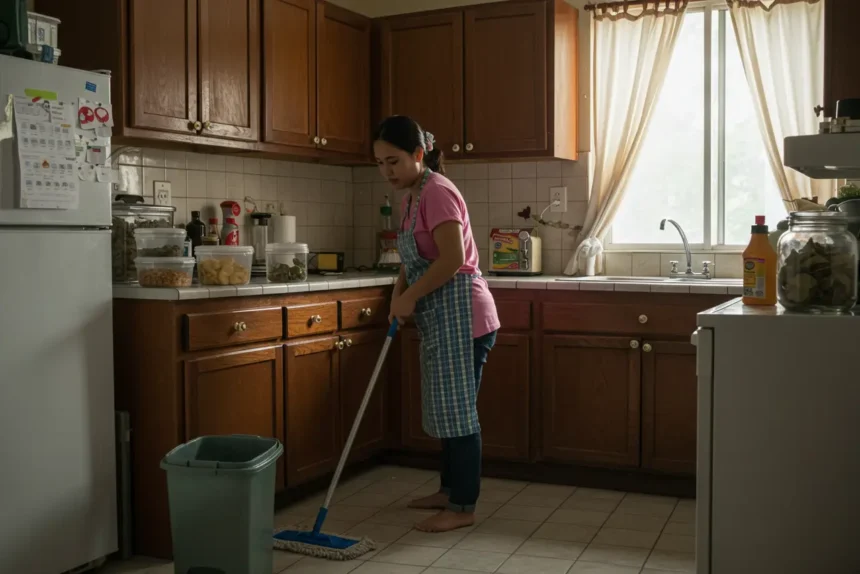If there’s one uninvited guest that almost every Pinoy household has faced, it’s the dreaded ipis (cockroach). They sneak out of drains, fly across the sala when you least expect it, or crawl out of kitchen cabinets just when you’re about to eat. Sa totoo lang, nothing makes us jump faster than seeing an ipis take flight!
- 🧹 1. Keep It Clean and Dry
- 🔨 2. Seal Entry Points
- 🍚 3. Baking Soda & Sugar Bait
- 🧴 4. Boric Acid Powder Trap
- 🌿 5. Diatomaceous Earth (DE)
- 🍃 6. Bay Leaves and Pandan
- 🌸 7. Essential Oils Spray
- 🧴 8. Soap and Water Spray
- 🪤 9. DIY Cockroach Traps
- 🌿 10. Natural Repellent Plants
- ❓ FAQs About Natural Cockroach Remedies
- 🏡 Wrapping It Up – A Practical Path to an Ipis-Free Home
- 📚 References
Cockroaches thrive in our tropical climate, and they love clutter, leftover crumbs, and moist spaces. The problem gets worse during the rainy season or kapag may tulo sa kusina. Many Filipinos reach for chemical sprays, but here’s the catch – they can be harmful to kids, pets, and even those with asthma.
That’s why more and more families are turning to natural cockroach remedies. Using simple, affordable items you already have at home, you can get rid of cockroaches without chemicals and keep your bahay safer and fresher. In this guide, we’ll share 10 proven natural cockroach killers and repellents that are family-friendly, Pinoy-tested, and budget-approved.
| Aspect | Chemical Sprays | Natural Remedies |
|---|---|---|
| Cost | ₱150–₱300 per can (recurring expense) | Often free or cheap (baking soda, bay leaves, DIY traps) |
| Safety | Can trigger asthma, harmful to kids & pets | Safe, non-toxic, eco-friendly |
| Effectiveness | Fast kill, but short-term (roaches come back) | Slower but long-term (breaks breeding & prevents return) |
| Smell | Strong, chemical odor | Herbal, fresh, or no scent at all |
| Best For | Quick emergency kill | Consistent prevention & everyday control |

🧹 1. Keep It Clean and Dry
The number one rule in cockroach control is simple: wag silang pakainin at patirahin. Ipis thrive where there’s food, water, and clutter.. and the best way to cut off their lifeline is through everyday cleanliness. You don’t need fancy cleaning supplies; consistency is what drives these pests away.
🔹 Step-by-Step Linis Routine for a Roach-Free Home
-
Wipe Down Food Surfaces Daily
-
After every meal or baon prep, wipe down the dining table, countertops, and stove with a damp cloth or vinegar solution. Crumbs and oil residue are like buffet invitations for cockroaches.
-
-
Wash Dishes Promptly
-
Leaving dirty plates overnight is like announcing an “open bar” for ipis. Even just rinsing dishes before bed prevents food particles from luring them.
-
-
Seal and Store Food Properly
-
Transfer rice, sugar, and snacks into sealed containers. Transparent plastic bins (madalas mabili sa Divisoria or palengke) not only keep food fresh but also prevent cockroach access.
-
-
Take Out the Trash Nightly
-
Don’t let garbage sit inside the house overnight. Use a trash bin with a lid and empty it before sleeping. A simple routine, but it starves roaches of their favorite midnight snack.
-
-
Fix Leaks and Remove Standing Water
-
Cockroaches need water more than food. That dripping faucet in the kusina or tulo under the lababo? That’s a free water station for pests. Seal leaks with tape or have them fixed ASAP.
-
-
Keep Floors and Corners Dry
-
After mopping, make sure corners and under-appliance areas aren’t left damp. Ipis love hiding in moist spaces behind the ref or under the sink.
-
-
Declutter Storage Areas
-
Old newspapers, grocery bags, and unused boxes are perfect cockroach hiding spots. Recycle or throw out what you don’t need, and keep storage neat.
-
🏡 Why Cleanliness is the Foundation
-
Removes Food Source – Without crumbs, spills, and basura, ipis have nothing to feed on.
-
Cuts Off Water Supply – Fixing leaks and drying surfaces forces them to move out.
-
Prevents Breeding – Clean, uncluttered spaces leave fewer dark, hidden spots for them to lay eggs.
💡 Pro Tip: Do a quick 10-minute nightly cleanup before bed – wipe, take out the trash, and dry the sink. Small habits like this make a huge difference in keeping your Pinoy home roach-free and fresh.
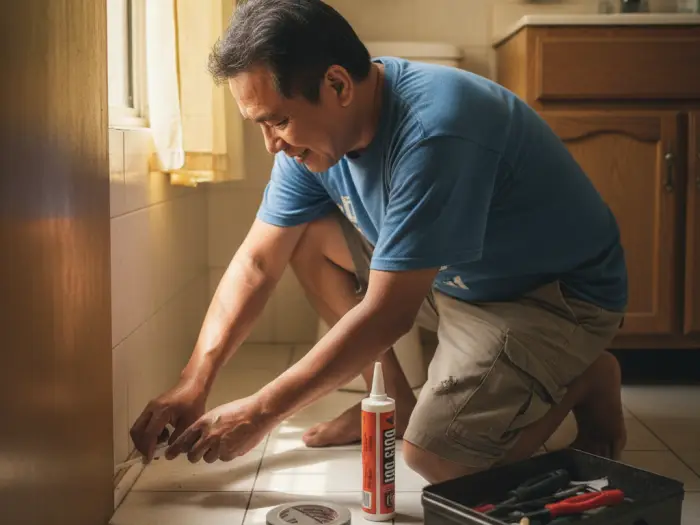
🔨 2. Seal Entry Points
Even the cleanest home can still attract ipis if they have an open door (literally). Cockroaches are masters at squeezing through the tiniest butas – cracks in the wall, gaps under the door, or even loose drains. The good news? With a little weekend DIY, you can block these entry points and make your bahay less welcoming.
🔹 DIY Steps to Block Cockroach Entry
-
Inspect Common Entry Points
-
Walk around your house with a flashlight. Look for gaps in walls, baseboards, door frames, and windows.
-
Pay special attention to areas near the kitchen, bathroom, and laundry – these spots have the most pipes and drains where ipis usually sneak in.
-
-
Seal Small Cracks and Holes
-
Use silicone caulk (affordable sa hardware) to fill in wall cracks and gaps around windows.
-
For temporary fixes, masking tape or duct tape works, but reapply regularly.
-
-
Fix Gaps Under Doors
-
If there’s space under your door, install a door sweep or weatherstripping. These are cheap and easy to install with just screws or adhesive.
-
No budget? A rolled-up basahan works as a quick hack to block the gap at night.
-
-
Cover Pipe and Drain Openings
-
Cockroaches love coming up through drains and floor holes.
-
Use mesh screens or fine wire netting to cover floor drains, air vents, or large pipe gaps. Secure with tape or zip ties.
-
-
Check Windows and Screens
-
Broken or missing screen? Replace or patch it up with screen repair tape (found in most hardware stores).
-
Keep windows shut during peak ipis activity (nighttime) if screens aren’t in place.
-
-
Seal Electrical and Plumbing Entry Points
-
Holes where wires or pipes pass through walls are like secret tunnels for cockroaches. Fill them with expandable foam or more caulking.
-
🛠️ Why Sealing Works
-
Keeps Roaches Out – No entry, no infestation. Simple as that.
-
Blocks Other Pests – Ants, lizards, and even mice use the same gaps. Sealing them gives you all-around protection.
-
Saves Energy Too – Sealed doors and windows improve airflow control, meaning cooler rooms and lower kuryente bills.
💡 Pro Tip: Make this a weekend family project. Assign each member an area to inspect, then seal together. Not only do you banish cockroaches, but you also strengthen your home’s defenses overall.
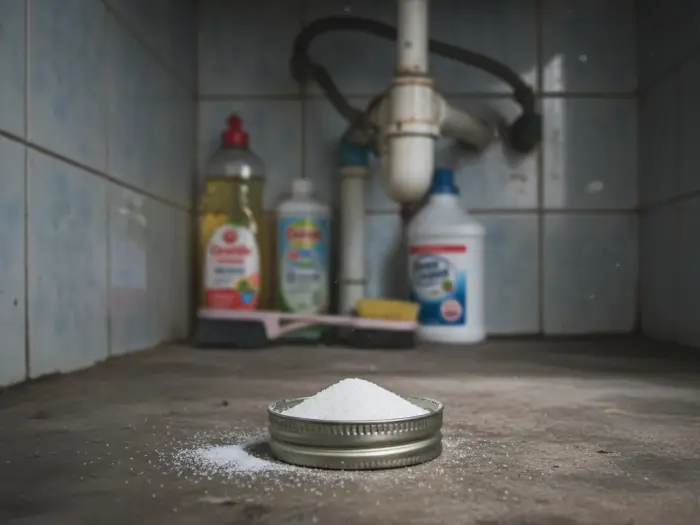
🍚 3. Baking Soda & Sugar Bait
One of the simplest, most budget-friendly ways to kill cockroaches is with a mix of baking soda and sugar – ingredients you probably already have in your kusina. This DIY remedy lures roaches in, then quietly does its job once they eat it.
📝 Ingredients
-
2 tablespoons baking soda (sodium bicarbonate)
-
2 tablespoons white sugar (or brown sugar, kung yun ang meron)
-
Small shallow containers (bottle caps, jar lids, or old saucers)
👣 Steps
-
Mix Equal Parts – Combine the baking soda and sugar in a small bowl.
-
Prepare Traps – Place the mixture into shallow lids or small containers.
-
Strategic Placement – Set these traps under the sink, behind the ref, in bathroom corners, or near basurahan – anywhere you often see ipis.
-
Refresh Weekly – Replace the mixture every 5–7 days to keep it effective, especially in humid areas.
⚠️ Caution
-
Keep Away from Kids and Pets. While baking soda and sugar are mostly safe, they can still cause upset stomachs if ingested in large amounts.
-
Place baits only in hidden corners where cockroaches roam, not in open food areas.
✅ Why It Works
The sugar attracts cockroaches, while the baking soda reacts with their stomach acids, creating gas they can’t release – leading to a safe, natural kill. It’s cheap, effective, and chemical-free.
💡 Pro Tip: For stronger results, sprinkle a thin line of baking soda mix along baseboards or near drains to catch roaming cockroaches at night.
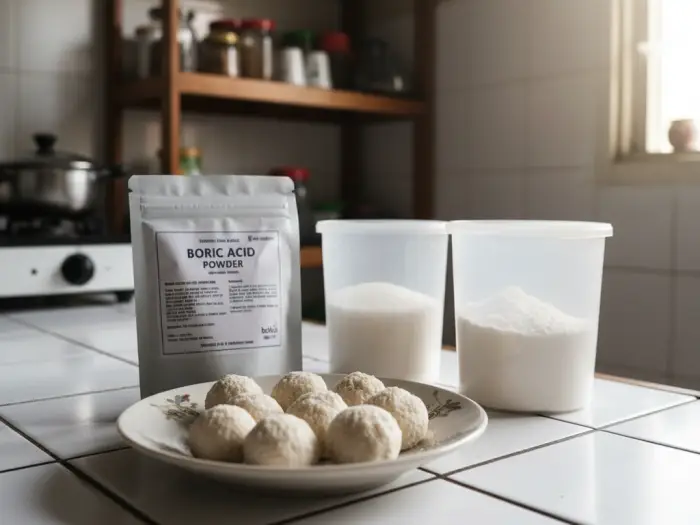
🧴 4. Boric Acid Powder Trap
Boric acid has been a classic ipis remedy for decades – affordable, effective, and available in most boticas and hardware stores. When cockroaches eat it, boric acid dehydrates and kills them over time. Here’s how to make your own safe but powerful traps.
📝 Ingredients
-
3 tablespoons boric acid powder
-
2 tablespoons white sugar
-
1 tablespoon flour or powdered milk (for binding and extra bait)
-
A few drops of water (optional, to form paste/balls)
👣 Steps
-
Mix Ingredients – Combine boric acid with sugar and flour (or milk powder). The sugar attracts roaches, while the flour helps form a sticky mixture.
-
Shape or Spread – Add a few drops of water and roll into small pea-sized balls, or keep it as a dry powder mix.
-
Place in Hidden Spots – Drop balls or sprinkle powder behind appliances, under the sink, along cabinets, and in other dark corners.
-
Reapply Every 2 Weeks – Replace old baits as they dry up or get eaten.
⚠️ Caution
-
Use Only in Hidden Areas. Boric acid is low-toxicity but can still harm kids and pets if ingested directly.
-
Avoid placing traps in food prep areas or open surfaces.
-
Always wash your hands after handling the powder.
✅ Why It Works
Once ingested, boric acid damages a cockroach’s digestive and nervous systems, while dehydrating them from the inside out. It’s a slow-acting but highly effective remedy that targets both adult roaches and their colonies.
💡 Pro Tip: Sprinkle a light dusting of boric acid along the pathways cockroaches travel (like under the ref or along bathroom walls). They’ll walk over it and carry the powder back to their nest, spreading it to others.
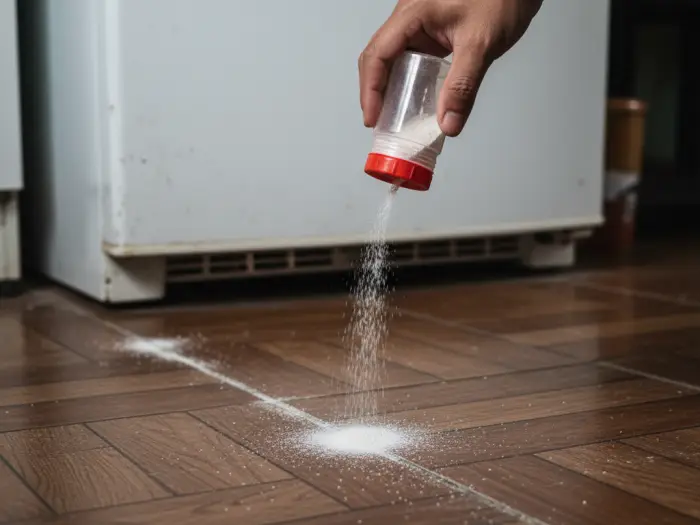
🌿 5. Diatomaceous Earth (DE)
Food-grade diatomaceous earth (DE) is a natural powder made from fossilized algae. Don’t be fooled by its soft, flour-like look – under a microscope, it’s sharp enough to scratch a cockroach’s exoskeleton, causing them to dehydrate and die. Safe for humans and pets (when food-grade), it’s a powerful, chemical-free pest control option.
📝 What to Buy
-
Food-grade diatomaceous earth (DE) – available online, in pet shops, or gardening stores (avoid “pool-grade” DE, which is unsafe for indoor use)
-
Small shaker container or spoon for spreading
👣 Steps
-
Identify Roach Hotspots – Look for dark, hidden areas where cockroaches travel: behind the ref, under the sink, baseboards, or bathroom corners.
-
Lightly Sprinkle DE – Apply a thin, even layer of DE along these pathways. Roaches must crawl through it for it to work.
-
Leave It Dry – DE only works when dry. Reapply if it gets wet (like near sinks or after mopping).
-
Vacuum & Reapply – After 1–2 weeks, vacuum up old powder and refresh the application as needed.
⚠️ Precautions
-
Always use food-grade DE. Pool-grade DE contains harmful chemicals.
-
Avoid inhaling the dust when applying. Use a mask if possible.
-
Safe around kids and pets when applied properly, but don’t sprinkle directly on food surfaces.
✅ Why It Works
DE doesn’t poison roaches – it dehydrates them physically, making it impossible for them to build resistance (unlike chemical sprays). It’s long-lasting and works silently as cockroaches crawl over treated areas.
💡 Pro Tip: Plantitos and plantitas use DE for gardening because it controls ants and pests in soil. This makes it a dual-purpose investment for your home and plants.
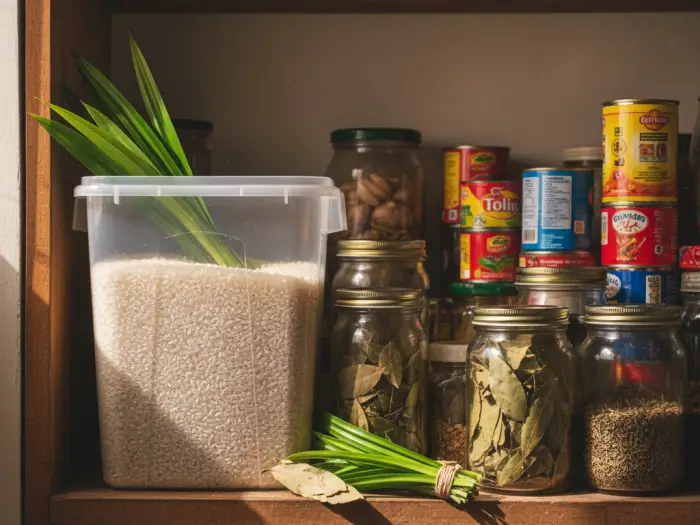
🍃 6. Bay Leaves and Pandan
Ask any lola about natural ways to keep pests away, and chances are she’ll mention bay leaves (laurel) or pandan leaves. These have long been staples in Filipino kitchens, not just for cooking adobo or making buko pandan, but also as natural pest repellents. Many households still tuck dried leaves inside cabinets and aparador, swearing they keep ipis out.
🌿 Why It Works (Science + Tradition)
-
Bay Leaves (Laurel) contain essential oils like eucalyptol and cineole, which have strong herbal scents. While they don’t kill cockroaches, the aroma can disrupt their foraging behavior, discouraging them from nesting nearby.
-
Pandan Leaves give off a sweet, grassy fragrance that many insects dislike. Anecdotally, households notice fewer roaches in pantries or drawers lined with fresh pandan strips.
-
Scientific studies are limited, but the concept is similar to how strong-smelling essential oils repel bugs – ipis prefer dark, damp, odorless spaces, so pungent scents confuse them.
👣 How to Use Them at Home
-
Dried Bay Leaves – Crush a few dried laurel leaves to release more scent, then scatter them inside cabinets, drawers, and food storage areas.
-
Fresh Pandan Leaves – Cut pandan into strips and tie them into small bundles. Place them near rice containers, pantry shelves, or behind the ref.
-
Replace Regularly – Bay leaves last longer when dried, but pandan needs replacement every 1–2 weeks as the scent fades.
🏡 Cultural Touch
There’s a reason these tips live on in Filipino homes. Beyond practicality, they connect us to a tradition of resourcefulness – using what’s already in the bahay or garden to solve problems. Plus, bonus na rin: your kitchen smells fragrant and fresh, not like harsh chemicals.
💡 Pro Tip: Combine bay or pandan leaves with stronger remedies (like DE or boric acid traps). Think of them as gentle “scent barriers” that make your home less attractive to ipis.
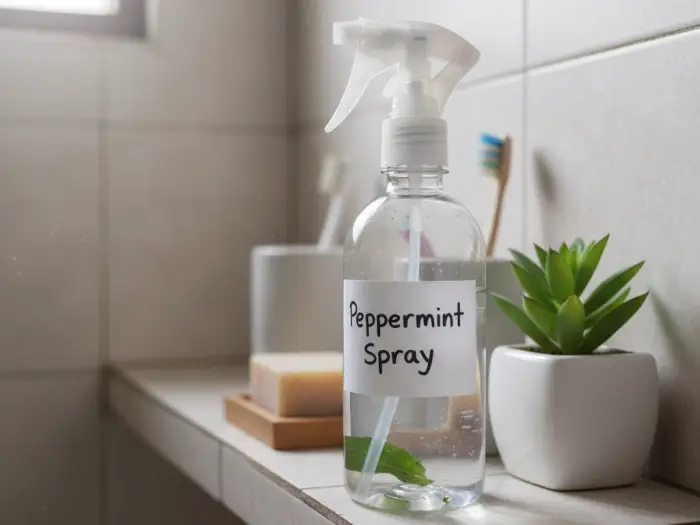
🌸 7. Essential Oils Spray
Essential oils aren’t just for relaxation or spa vibes – they can also double as natural cockroach repellents. Scents like peppermint, eucalyptus, and citronella are known to drive ipis away while leaving your home smelling fresh.
📝 Ingredients
-
10–15 drops peppermint oil (or eucalyptus/citronella as alternatives)
-
1 cup water
-
1 tablespoon white vinegar (optional, boosts cleaning and scent)
-
1 spray bottle
👣 Steps
-
Mix the Solution – Combine water, vinegar, and essential oil drops in the spray bottle. Shake well before each use.
-
Target Hotspots – Spray along baseboards, under the sink, around drains, and in bathroom corners where cockroaches usually appear.
-
Reapply Regularly – Refresh every 2–3 days or when the scent fades.
⚠️ Caution
-
While natural, essential oils can still irritate sensitive pets (especially cats). Use sprays in areas they don’t directly access.
-
Avoid spraying directly on food prep surfaces. Use a cloth to wipe those areas with plain water after cleaning.
✅ Why It Works
Cockroaches have a highly sensitive sense of smell. Strong scents like peppermint overwhelm and repel them, discouraging nesting in treated areas. Bonus: your home smells like a fresh spa instead of a chemical lab.
💡 Pro Tip: Rotate oils (peppermint this week, citronella the next) to keep scents strong and effective against ipis.
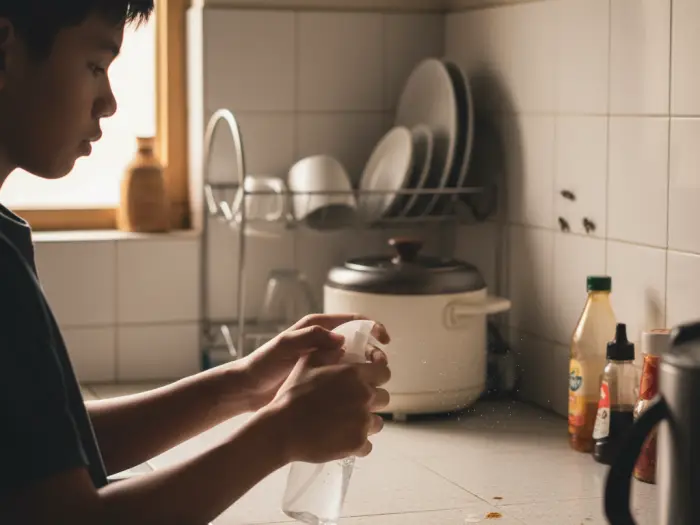
🧴 8. Soap and Water Spray
You don’t always need chemical insect sprays to kill an ipis on the spot. A simple mix of soap and water works surprisingly well – suffocating cockroaches almost instantly while being safe to use around kids and pets.
📝 Ingredients
-
2 cups water
-
1–2 teaspoons dish soap (any brand will do)
-
1 spray bottle
👣 Steps
-
Mix the Solution – Add dish soap to water in the spray bottle. Shake gently to combine.
-
Spot and Spray – When you see a cockroach, spray directly until its body is coated. The soapy water clogs their breathing pores (spiracles), suffocating them.
-
Wipe Clean – After a few minutes, wipe the area with tissue or a rag and dispose of the ipis properly.
⚠️ Caution
-
Best for direct kills only – this won’t prevent future infestations.
-
Use only on non-sticky surfaces; too much soap can leave residue on wood or tiles.
✅ Why It Works
Soap molecules break down the cockroach’s waxy outer layer and clog their breathing pores, causing them to suffocate. It’s an eco-friendly and instant kill option when you need to act fast.
💡 Pro Tip: Keep a small soap spray bottle handy in the kitchen or bathroom. Think of it as your “emergency ipis weapon” without the harsh fumes.

🪤 9. DIY Cockroach Traps
If sprays and powders aren’t your style, traps are a low-cost and chemical-free way to catch cockroaches. With just a few items from your kusina, you can build effective roach traps that silently reduce their numbers over time.
📝 Materials
-
Old glass jar or shallow bowl
-
2–3 tablespoons of beer, coffee, or sugar water (bait)
-
A strip of paper or cardboard (as a ladder)
-
A few drops of cooking oil or petroleum jelly
👣 Steps
-
Prepare the Jar Trap – Pour a small amount of beer, coffee with sugar, or sugar water into the jar.
-
Make a Ladder – Tape a strip of cardboard or folded paper from the floor to the rim of the jar so roaches can climb in.
-
Grease the Inside – Rub cooking oil or petroleum jelly inside the jar’s walls to make it too slippery for roaches to climb out.
-
Place Strategically – Leave the jar trap overnight near basurahan, under the sink, or dark corners.
-
Dispose & Refresh – In the morning, flush caught roaches down the toilet, wash the jar, and reset with fresh bait.
⚠️ Caution
-
Keep traps away from kids and pets to avoid spills.
-
Check traps daily to dispose of roaches promptly.
✅ Why It Works
Roaches are drawn to strong-smelling baits like beer and coffee. Once inside the slippery trap, they can’t escape – a simple and effective way to naturally reduce cockroach populations over time.
💡 Pro Tip: For a simpler version, use a shallow dish with beer or coffee + a few drops of oil. Roaches will drown once they fall in.
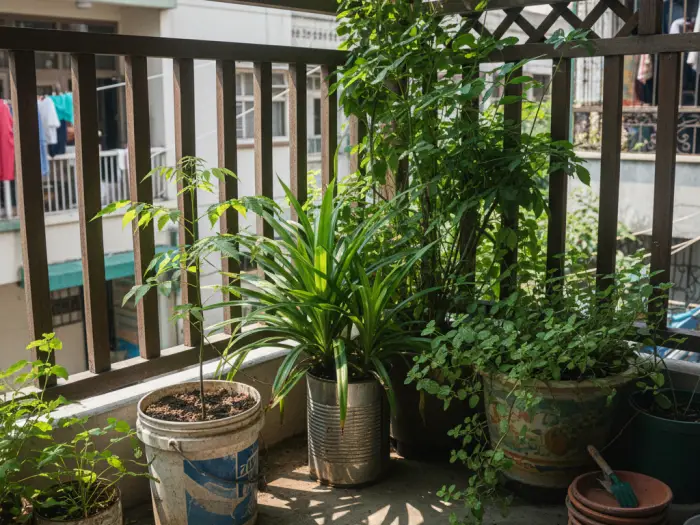
🌿 10. Natural Repellent Plants
Some plants don’t just beautify your bahay – they can also help keep ipis away. By adding these natural repellents to your home or garden, you create a less inviting environment for cockroaches.
🌱 Plants That Help Repel Cockroaches
-
Neem (Azadirachta indica)
-
Widely used in natural pest control, neem leaves or oil repel cockroaches and other insects.
-
Place dried neem leaves in cabinets or mix neem oil with water for a natural spray.
-
-
Catnip (Nepeta cataria)
-
Contains nepetalactone, a compound cockroaches hate.
-
Scatter dried catnip leaves in problem areas or brew into a mild spray. Bonus: your cats will love it!
-
-
Pandan Leaves
-
Already a Pinoy kitchen favorite, pandan doubles as a mild roach repellent.
-
Place fresh bundles near rice containers or pantry shelves for both fragrance and function.
-
-
Bay Laurel (Laurel leaves)
-
Used in cooking adobo, dried bay leaves are also believed to deter cockroaches.
-
Crush a few leaves and tuck them into drawers, cabinets, or pantry corners.
-
-
Mint and Peppermint
-
Strong minty scents overwhelm cockroaches.
-
Grow mint in small pots near windows or use peppermint leaves as natural repellents.
-
✅ Why Plants Work
Cockroaches dislike strong herbal or minty odors, and these plants naturally release scents that make your home unappealing to them. While they won’t kill roaches, they work best as preventive barriers when combined with other remedies like baits or traps.
💡 Pro Tip: Place repellent plants in kitchens, pantries, and entry points for maximum effect. They add greenery to your bahay while silently keeping ipis away.
❓ FAQs About Natural Cockroach Remedies
Q1: Ano ang pinakamabisang natural na panlaban sa ipis?
Boric acid and diatomaceous earth are the most effective because they kill roaches over time. For repellents, peppermint oil and neem leaves work best.
Q2: Gaano katagal bago makita ang resulta ng natural remedies?
Most natural baits and powders take a few days to a week. With consistent use and cleaning, you’ll notice fewer roaches within 2–3 weeks.
Q3: Safe ba ang baking soda method kung may bata at aso sa bahay?
Yes, it’s safer than chemicals, but still keep baits out of reach. Ingesting large amounts can upset a child’s or pet’s stomach.
Q4: Anong natural remedy ang puwedeng gamitin agad kung may ipis na lumabas?
The soap-and-water spray is the fastest DIY option. It suffocates cockroaches instantly and is safe to keep in the kitchen or bathroom.
Q5: Pwede bang pagsabayin ang iba’t ibang natural remedies?
Yes! Combining traps, powders, and repellents gives the best results. For example, use DE on the floor, boric acid baits in corners, and peppermint spray on baseboards.
Q6: Totoo bang takot ang ipis sa liwanag?
They’re nocturnal, so they prefer dark areas. Keeping spaces well-lit won’t kill them, but it discourages them from roaming openly.
Q7: Nakakatulong ba ang general cleaning lang para mawala ang ipis?
Cleaning is the foundation, but it’s not enough for infestations. You still need baits, traps, and repellents to fully get rid of them.
Q8: Safe ba ang diatomaceous earth kung may baby sa bahay?
Food-grade DE is safe, but avoid inhaling the dust. Apply only in hidden corners and keep the powder away from crawling areas where babies play.
Q9: May natural remedy ba na pwedeng gamitin sa drainage o lababo?
Yes. Pouring boiling water with vinegar or baking soda down the drain helps kill eggs and flush out cockroaches hiding in pipes.
Q10: Paano ko mapapanatiling ipis-free ang bahay after mawala sila?
Continue sealing entry points, cleaning nightly, and keeping bay leaves or peppermint spray in problem areas. Consistency prevents roaches from coming back.
🏡 Wrapping It Up – A Practical Path to an Ipis-Free Home
Cockroaches are a hassle, pero hindi ka helpless. With a mix of cleaning, sealing entry points, natural baits, and plant-based repellents, you can dramatically reduce or even eliminate their presence. Think of it as building layers of defense:
-
Clean and dry home = no food or water for ipis.
-
Sealed gaps = no easy entry.
-
DIY baits and traps = population control.
-
Natural scents and plants = long-term deterrent.
The best results come from consistency. Hindi sapat na minsan lang maglinis o maglagay ng bait – it’s about turning these hacks into part of your regular home routine. And unlike chemical sprays, these methods are safer, cheaper, and better for your family’s health.
So the next time an ipis crawls out of the drain, alam mo na ang gagawin. With these natural remedies, you can keep your bahay cleaner, fresher, and most importantly, ipis-free – all without relying on harsh chemicals.



